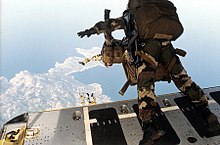
Back HALO/HAHO Catalan Military Freefall German Paracaidismo militar a gran altitud Spanish HALO-hyppy Finnish Chute opérationnelle French צניחה צבאית מגובה רב HE HALO ugrás Hungarian HALO (paracadutismo) Italian 自由降下 Japanese Militaire vrije val Dutch
This article includes a list of general references, but it lacks sufficient corresponding inline citations. (August 2011) |


High-altitude military parachuting, or military free fall (MFF), is a method of delivering military personnel, military equipment, and other military supplies from a transport aircraft at a high altitude via free-fall parachute insertion. Two techniques are used: HALO (high altitude – low opening, often called a HALO jump) and HAHO (high altitude – high opening).
In the HALO technique, the parachutist opens the parachute at a low altitude after free-falling for a period of time, while in the HAHO technique, the parachutist opens the parachute at a high altitude just a few seconds after jumping from the aircraft.
Although HALO techniques were first developed in the 1960s for military use, in recent years HALO parachute designs have been more widely used in non-military applications, including as a form of skydiving.[1][2]
In military operations, HALO is also used for delivering equipment, supplies, or personnel, while HAHO is generally used exclusively for personnel. In typical HALO/HAHO insertions the troops jump from altitudes between 15,000 and 35,000 feet (4,600 and 10,700 m).[3] Military parachutists will often reach a terminal velocity of 126 mph (203 km/h), allowing for a jump time under two minutes.[3]
- ^ "Civilian HALO Skydive from 30,000 ft. | TEEM". TEEM. 2015-06-10. Retrieved 2018-08-22.
- ^ Taft, Jay. "Skydivers set to soar from 23,000 feet in Rochelle; unlike anywhere else in the Midwest". Rockford Register Star. Retrieved 2018-08-22.
- ^ a b "High-Altitude Airdrop Missions (HAAMS) High Altitude-Low Opening (HALO) and High Altitude-High Opening (HAHO)". GlobalSecurity.org. Retrieved 2012-01-07.
© MMXXIII Rich X Search. We shall prevail. All rights reserved. Rich X Search